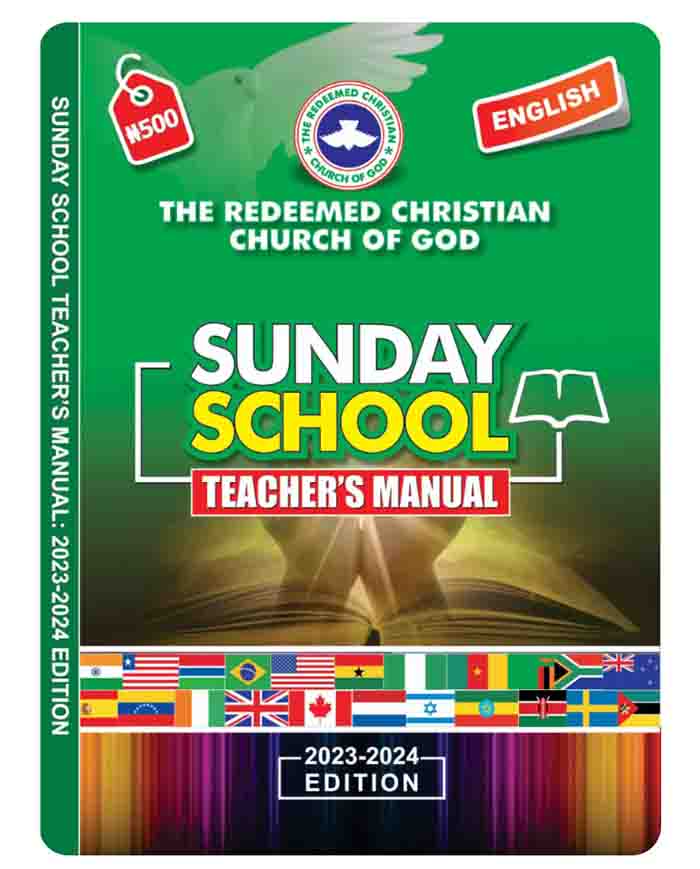This is RCCG Sunday School Teachers manual 10 September 2023 for the adult class. The Lesson TWO topic is THEOPHANY.
Read:
- RCCG Sunday School Students Manual 10 September 2023
- Open Heaven 10 September 2023 Devotional
- RCCG YAYA Sunday School 10 September 2023 Manual
- RCCG House Fellowship Manual 10 September 2023

RCCG SUNDAY SCHOOL TEACHERS MANUAL 10 SEPTEMBER 2023 (LESSON 2)
TOPIC: THEOPHANY
Note: Check RCCG SUNDAY SCHOOL HYMN LYRICS
OPENING PRAYER
Father, help me to understand Your manifold presence.
PREVIOUS KNOWLEDGE
The teacher should allow the assistant teacher to review the lesson for the previous week.
BIBLE PASSAGE: Genesis 18:1-3, 16-22 (KJV)
1 And the Lord appeared unto him in the plains of Mamre: and he sat in the tent door in the heat of the day;
2 And he lift up his eyes and looked, and, lo, three men stood by him: and when he saw them, he ran to meet them from the tent door, and bowed himself toward the ground,
3 And said, My Lord, if now I have found favour in thy sight, pass not away, I pray thee, from thy servant:
16 And the men rose up from thence, and looked toward Sodom: and Abraham went with them to bring them on the way.
17 And the Lord said, Shall I hide from Abraham that thing which I do;
18 Seeing that Abraham shall surely become a great and mighty nation, and all the nations of the earth shall be blessed in him?
19 For I know him, that he will command his children and his household after him, and they shall keep the way of the Lord, to do justice and judgment; that the Lord may bring upon Abraham that which he hath spoken of him.
20 And the Lord said, Because the cry of Sodom and Gomorrah is great, and because their sin is very grievous;
21 I will go down now, and see whether they have done altogether according to the cry of it, which is come unto me; and if not, I will know.
22 And the men turned their faces from thence, and went toward Sodom: but Abraham stood yet before the Lord.
MEMORY VERSE: Exodus 34:5 (KJV)
And the LORD descended in the cloud, and stood with him there, and proclaimed the name of the LORD.
INTRODUCTION
The term “Theophany” comes from the Ancient Greek theophaneia, meaning of a deity.” Specifically, a “theophany” is a visible or tangible manifestation of God.
In its most restrictive sense, it is a visible appearance of God in the Old Testament period, often, but not always, in human form.
The use of the term “theophany” is restricted here to manifestations of God in temporary forms visible to the eyes (not in dreams).
A frequent introduction for theophanies may be seen in the phrase “the Lord came down” (Genesis 11:5; Exodus 34:5).
TEACHER’S DIARY
LESSON AIM:
To teach the church some temporary forms God takes to appear to His people.
TEACHING OBJECTIVES:
Through this study, students are expected to:
a. Know what theophany means in clear terms.
b. Understand the difference between theophany and other divine manifestations of God.
c. Discover people who experienced theophany in the Bible.
d. Distinguish between theophany and Christ’s incarnation.
e. Understand the significance of theophany.
TEACHING PLAN:
To achieve the above-stated objectives, the teacher should:
a. Allow the students to recite the memory verse, read the Bible passage, contribute to the discussion; do class activities and the assignment.
b. Allow the Assistant Teacher to see to the well-being of the class, mark attendance and assignment.
c. Teach the lesson outlines, summarise, conclude, evaluate the lesson and give an assignment.
TEXT REVIEW:
Genesis 18:1-3, 16-22.
A. In the above texts, the writer gives an account of the Lord’s appearance unto Abraham, saying:
i. And the Lord appeared unto him in the plains of Mamre: and he sat in the tent door in the heat of the day; V1.
ii. And he lifted up his eyes and looked, and lo, ……………… V2.
iii. And he said, My Lord, ……………… V3.
B. The writer further gives a narration of how God revealed His plan for Sodom to Abraham, that:
iv. The men rose up thence, ……………. V16.
v. And the Lord said, shall
vi. Seeing that Abraham shall surely …………….. V18.
vii. For I know him, that ……………… V19.
viii. And the LORD said, ………………. V20.
xi. I will go down now, and …………………… V21.
x. And the men turned their faces from thence, and …………………. V22.
TEACHING METHOD:
The Lecture Method.
OUTLINES:
1. CATEGORIES AND BIBLICAL INSTANCES
2. THE INCARNATION OF CHRIST
1. CATEGORIES AND BIBLICAL INSTANCES
A. Some of the tangible or visible manifestations of God are found in three categories: appearance as a man, non-human form, and appearance as ‘The angel of the LORD’.
B. Biblical instances of God appearance include:
1. As a Man
i. Genesis 18:1-3, 13, 17 – Abraham had some visitors: two angels and God Himself. He invited them to come to his home, and he and Sarah entertained them.
ii. Genesis 32:22-30 – Jacob wrestled with what appeared to be a man, but was God (vs.28-30).
iii. Daniel 3:23-25 – The fourth man in the fire is none other than God.
2. In Non-Human Form:
i. Exodus 24: Frequently, the term “glory of the Lord” reflects a theophany.
ii. Deuteronomy 31:14-15 God appeared to Moses and Joshua in the transfer of leadership to Joshua “…in a pillar of cloud….”
3. As “The Angel of the LORD”: This is also called “Angelophany.” There is a difference between “an angel” and “the Angel of the Lord.”
The Angel of the Lord usually refers to himself as the Lord or God in the Old Testament. It is not every appearance of angels that is a theophany.
i. Genesis 16:7-14 – The angel of the Lord appears to Hagar. The angel speaks as God himself in the first person, and in verse 13 Hagar identifies “the LORD that spoke to her” as “The God” Who sees.”
ii. Genesis 22:11-12 – The angel of the Lord appears to Abraham and refers to himself as God in the first person.
iii. Genesis 31:11-13 – “The angel of God” says, “…I am the God of Beth-el”.
CLASS ACTIVITY 1:
Students should share with the class any of the above categories of theophany, they have encountered God.
2. THE INCARNATION OF CHRIST
A. The pre-incarnate appearance of Christ (in the Old Testament) is called “Christophany.”
i. Jesus is the fulfilment of God’s presence.
ii. He is the one to which every theophany – in the Old Testament was pointing (Hebrews 1:1-3; John 1:1, 14).
B. However, the incarnation of Christ is different from the Old Testament instances of theophany.
i. The Old Testament theophanies are preliminary they foreshadow and prefigure the coming of Christ in the flesh.
ii. The coming of Christ is their fulfilment – their climax (Matthew 5:17).
iii. In addition, Christ’s incarnation is permanent.
iv. The theophanies in the Old Testament were temporary.
C. It is through Jesus that we will finally and fully experience the presence of God with us (Revelation 21:1-4).
CLASS ACTIVITY 2:
The class should discuss why they believe Christ is the fullness of God’s presence any man could wish for.
CONCLUSION: RCCG SUNDAY SCHOOL TEACHERS MANUAL 10 SEPTEMBER 2023
The main point of a theophany is to know that God is present with humanity. That is ultimately expressed through Christ.
QUESTION
* Mention the three categories of the visible manifestations of God.
* Explain the incarnation of Christ.
EVALUATION:
Teachers should ask the students to distinguish between Old Testament theophany and re-incarnation of Christ in at least three (3) ways.
CLOSING PRAYER:
Father, saturate my life with your manifold presence.
RCCG SUNDAY SCHOOL TEACHERS MANUAL 10 SEPTEMBER 2023 ASSIGNMENT
Write five reasons people still doubt God’s existence despite the pieces of evidence in the Scriptures and around us. (2×5-10 marks).




